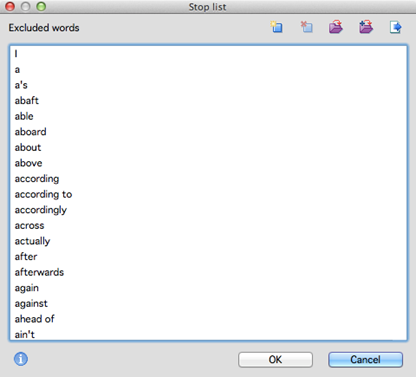 |
Function of the Stop Lists
Stop lists are collections of “uninteresting” words, such as definite and indefinite articles, conjunctions, or numerals. Such words are usually sources of irritation when analyzing a text. For that reason, it is advisable to exclude them from the analysis. MAXDictio allows you to create as many stop lists as you’d like, as well as to edit and manage them. Words that are in the stop lists will automatically left out of the table of counting results.
Creating Stop Lists
To create a stop list, you can either call up the option Stop list in the MAXDictio menu or click on the quick-button in the MAXDictio toolbar.

Quick button “Stop list” in the MAXDictio toolbar

The stop list includes an overview of the words that are left out of the count
There are two different ways to add words to a stop list:
q First, you can enter
them by hand by clicking on the button New  found on the top of the “Excluded
words” list and then typing the appropriate word.
found on the top of the “Excluded
words” list and then typing the appropriate word.
q Second, you can select words form a word frequency list and add them to a stop list by double-clicking on them. This allows you to avoid entering these words individually.
Tip: It is also possible
to transfer several words from the Word frequency list into a stop list at once.
To do this, select all of the desired words by holding down the Ctrl-key (Win)
or cmd-key (Mac). Then, click on the button  Add to stop list.
Add to stop list.
The words in a stop list are automatically arranged in alphabetical order. This order is pre-set and cannot be modified. If a word already exists in the stop list, it will not be added.
Saving, Loading, Adding and Printing Stop Lists
Note: Since the project format mx11 the acutally loaded stoplist is always saved in the project file. This has the big advantage that you can transfer your project to other computer without any problems and that you have access to the last used stop list immediately.
Stop lists can be exported as files. This allows you to manage
as many stop lists as you’d like. Such lists can then be opened when needed. Two
stop lists can also be merged (button: Add stop list  ).
).
If you wish to print out a stop list for means of documentation, first save it using the Save option. The file will automatically be saved in TXT-format, which can be read with all conventional programs. Now you could, for instance, double-click on the file in Windows Explorer, which will open the Editor, from where you can print the file. You can also open the file in MS Word or Excel.
Dynamic Stop Lists
The active stop list is managed dynamically. When a word from the word frequency list has been moved to the stop list, a red stop sign appears next to it. By clicking on the word anew so that the stop-icon disappears, the word will be removed from the stop list.
 Creating and Editing Stop Lists in Office
Programs
Creating and Editing Stop Lists in Office
Programs
© VERBI Software. Consult. Sozialforschung. GmbH, Berlin 2014, v11.1.0 |